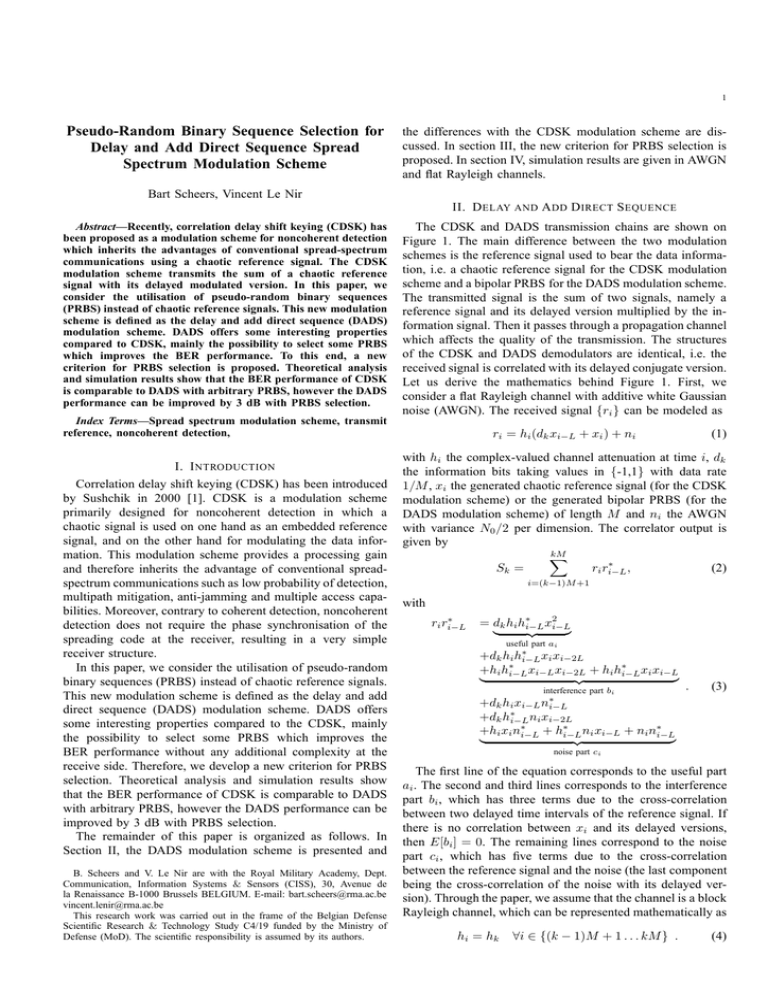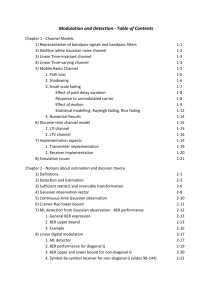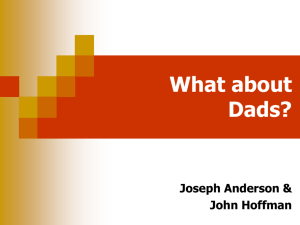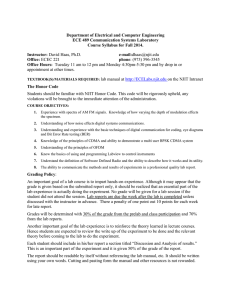Pseudo-Random Binary Sequence Selection for Delay and Add
advertisement

1
Pseudo-Random Binary Sequence Selection for
Delay and Add Direct Sequence Spread
Spectrum Modulation Scheme
the differences with the CDSK modulation scheme are discussed. In section III, the new criterion for PRBS selection is
proposed. In section IV, simulation results are given in AWGN
and flat Rayleigh channels.
Bart Scheers, Vincent Le Nir
II. D ELAY AND A DD D IRECT S EQUENCE
Abstract—Recently, correlation delay shift keying (CDSK) has
been proposed as a modulation scheme for noncoherent detection
which inherits the advantages of conventional spread-spectrum
communications using a chaotic reference signal. The CDSK
modulation scheme transmits the sum of a chaotic reference
signal with its delayed modulated version. In this paper, we
consider the utilisation of pseudo-random binary sequences
(PRBS) instead of chaotic reference signals. This new modulation
scheme is defined as the delay and add direct sequence (DADS)
modulation scheme. DADS offers some interesting properties
compared to CDSK, mainly the possibility to select some PRBS
which improves the BER performance. To this end, a new
criterion for PRBS selection is proposed. Theoretical analysis
and simulation results show that the BER performance of CDSK
is comparable to DADS with arbitrary PRBS, however the DADS
performance can be improved by 3 dB with PRBS selection.
Index Terms—Spread spectrum modulation scheme, transmit
reference, noncoherent detection,
I. I NTRODUCTION
Correlation delay shift keying (CDSK) has been introduced
by Sushchik in 2000 [1]. CDSK is a modulation scheme
primarily designed for noncoherent detection in which a
chaotic signal is used on one hand as an embedded reference
signal, and on the other hand for modulating the data information. This modulation scheme provides a processing gain
and therefore inherits the advantage of conventional spreadspectrum communications such as low probability of detection,
multipath mitigation, anti-jamming and multiple access capabilities. Moreover, contrary to coherent detection, noncoherent
detection does not require the phase synchronisation of the
spreading code at the receiver, resulting in a very simple
receiver structure.
In this paper, we consider the utilisation of pseudo-random
binary sequences (PRBS) instead of chaotic reference signals.
This new modulation scheme is defined as the delay and add
direct sequence (DADS) modulation scheme. DADS offers
some interesting properties compared to the CDSK, mainly
the possibility to select some PRBS which improves the
BER performance without any additional complexity at the
receive side. Therefore, we develop a new criterion for PRBS
selection. Theoretical analysis and simulation results show
that the BER performance of CDSK is comparable to DADS
with arbitrary PRBS, however the DADS performance can be
improved by 3 dB with PRBS selection.
The remainder of this paper is organized as follows. In
Section II, the DADS modulation scheme is presented and
B. Scheers and V. Le Nir are with the Royal Military Academy, Dept.
Communication, Information Systems & Sensors (CISS), 30, Avenue de
la Renaissance B-1000 Brussels BELGIUM. E-mail: bart.scheers@rma.ac.be
vincent.lenir@rma.ac.be
This research work was carried out in the frame of the Belgian Defense
Scientific Research & Technology Study C4/19 funded by the Ministry of
Defense (MoD). The scientific responsibility is assumed by its authors.
The CDSK and DADS transmission chains are shown on
Figure 1. The main difference between the two modulation
schemes is the reference signal used to bear the data information, i.e. a chaotic reference signal for the CDSK modulation
scheme and a bipolar PRBS for the DADS modulation scheme.
The transmitted signal is the sum of two signals, namely a
reference signal and its delayed version multiplied by the information signal. Then it passes through a propagation channel
which affects the quality of the transmission. The structures
of the CDSK and DADS demodulators are identical, i.e. the
received signal is correlated with its delayed conjugate version.
Let us derive the mathematics behind Figure 1. First, we
consider a flat Rayleigh channel with additive white Gaussian
noise (AWGN). The received signal {ri } can be modeled as
ri = hi (dk xi−L + xi ) + ni
(1)
with hi the complex-valued channel attenuation at time i, dk
the information bits taking values in {-1,1} with data rate
1/M , xi the generated chaotic reference signal (for the CDSK
modulation scheme) or the generated bipolar PRBS (for the
DADS modulation scheme) of length M and ni the AWGN
with variance N0 /2 per dimension. The correlator output is
given by
kM
X
∗
ri ri−L
,
(2)
Sk =
i=(k−1)M+1
with
∗
ri ri−L
= dk hi h∗i−L x2i−L
{z
}
|
useful part ai
+dk hi h∗i−L xi xi−2L
+hi h∗i−L xi−L xi−2L + hi h∗i−L xi xi−L
|
{z
}
interference part bi
.
(3)
+dk hi xi−L n∗i−L
+dk h∗i−L ni xi−2L
+hi xi n∗i−L + h∗i−L ni xi−L + ni n∗i−L
{z
}
|
noise part ci
The first line of the equation corresponds to the useful part
ai . The second and third lines corresponds to the interference
part bi , which has three terms due to the cross-correlation
between two delayed time intervals of the reference signal. If
there is no correlation between xi and its delayed versions,
then E[bi ] = 0. The remaining lines correspond to the noise
part ci , which has five terms due to the cross-correlation
between the reference signal and the noise (the last component
being the cross-correlation of the noise with its delayed version). Through the paper, we assume that the channel is a block
Rayleigh channel, which can be represented mathematically as
hi = hk
∀i ∈ {(k − 1)M + 1 . . . kM } .
(4)
2
Chaotic source
(CDSK)
or
PRBS generator [-1,1]
(DADS)
xi
+
ri
Channel
Delay L x
×
i−L
P
×
Delay L
()∗
∗
Sk
ri ri−L
M
Threshold
detector
Recovered
bits dˆk
∗
ri−L
Information bits dk
(rate 1/M)
Fig. 1.
Transmission chains of the CDSK and DADS modulation schemes
Let us define the output corresponding to the useful part
Ak , interference part Bk and noise part Ck
kM
X
{Ak , Bk , Ck } =
{ai , bi , ci }.
0
10
−1
(5)
10
Considering a PRBS for the DADS modulation scheme and
assuming that the delay L ≪ M, the useful part becomes
Ak = dk |hk |2 M Ps with Ps the energy per chip. Because
xi is statistically independent from xj for any i 6= j, xi is
statistically independent from nj for any (i, j), and ni is statistically independent from nj for any i 6= j, the interference
part Bk and the noise part Ck can be approximated as zeromean Gaussian variables as M increases with variances
var[Bk |dk ] = 3|hk |4 M Ps2
(6)
N2 .
var[Ck |dk ] = 4|hk |2 M Ps N20 + M 20
A semi-analytical approach to evaluate the bit error rate
(BER) performance is to average the conditional BER over
the channel realisations hk [2]. The BER formula [3] is then
given by
BER
= E[P"((Bk + Ck ) > Ak |dk )]
!#
|hk |2 M Ps
1
= E erfc p
2
2(var[Bk |dk ] + var[Ck |dk ])
(7)
with E[.] the expected value over the channel realisations
and erfc(.) the complementary error function. Knowing that
a transmitted data bit is the sum of two sequences of length
M , the energy per bit Eb can be written as Eb = 2M Ps , and
the BER formula becomes
v
"
!#
u
1
u
|hk |2 Eb
BER = E erfc t
2
MN0
k | Eb
2
8N0 (1 + 3|h
4MN0 + 2|hk |2 Eb )
(8)
Note that in an AWGN channel (hk = 1, ∀k) the performance can be improved by multiplying the received signal by
its non-conjugate delayed version [1]
Sk =
kM
X
ri ri−L .
BER
i=(k−1)M+1
−2
10
−3
10
−4
10
0
M=511 AWGN theo
M=511 AWGN simu
M=1023 AWGN theo
M=1023 AWGN simu
M=2047 AWGN theo
M=2047 AWGN simu
M=511 Rayleigh theo
M=511 Rayleigh simu
M=1023 Rayleigh theo
M=1023 Rayleigh simu
M=2047 Rayleigh theo
M=2047 Rayleigh simu
10
20
Eb/N0 (dB)
30
40
Fig. 2. Simulation results of the DADS modulation scheme in AWGN and
flat Rayleigh channels
In order to evaluate the theoretical formulas given in (7) and
(8), we have simulated the baseband transmission chain given
in Figure 1. Figure 2 shows the theoretical and simulated BER
performance of the DADS modulation scheme using arbitrary
PRBS in AWGN and flat Rayleigh channels for various lengths
of the spreading code (reference signal) M =511,1023 and
2047 with delay L=2. For CDSK, different BER formulas can
be obtained depending on the chaotic map [1], [4]. However,
simulations reveal that for BER values higher than 10−5 ,
the BER curves for CDSK and DADS modulation coincide
for both AWGN and Rayleigh channels. The figure shows
that there is a performance degradation for both propagation
channels as the length of the spreading code M increases. An
explanation for this behavior is the variance of the interference
and noise parts in (6) which are function of M . If we look at
the performance results, a loss of about 1.0 dB appears when
the length of the reference signal M doubles. This means that
a processing gain of about 2.0 dB can still be achieved by
doubling the length of M .
(9)
i=(k−1)M+1
The useful part Ak and the variance of the interference part
var[Bk |dk ] are unchanged. However, the variance of the noise
N2
part becomes var[Ck |dk ] = 4M Ps N20 + M 40 , leading to
!
s
1
Eb
.
(10)
BER = erfc
3Eb
0
2
+ MN
8N0 (1 + 4MN
4Eb )
0
III. P SEUDO R ANDOM B INARY S EQUENCE S ELECTION
FOR DADS
PRBS selection plays a prominent role in the performance
of a DADS modulation scheme. In this Section, a new criterion
is proposed for PRBS selection. This criterion may be used
to select a finite number of codes from a given codeset. It
is found that with the proposed criterion there is about 3 dB
3
improvement in the BER performance compared to arbitrary
PRBS. The idea is to select the sequence {xi } such that
the first term of the interference part bi in (3) moves to the
useful part ai while keeping the same properties of the other
components in the interference part. This can be done under
the following conditions
select {xi } =
−1
10
BER
0
10
xi = xi−2L
∀i
.
E[xi xi−L ] = 0
−2
10
(11)
−3
10
Using this criterion and considering a block Rayleigh channel, (3) can be re-written as
−4
10
∗
ri ri−L
2
(x2i
= dk |hk |
+
|
{z
x2i−L )
useful part ai
2
}
interference part bi
+dk hk xi−L n∗i−L
+dk h∗k ni xi−2L
+hk xi n∗i−L + h∗k ni xi−L + ni n∗i−L
|
{z
}
.
20
Eb/N0 (dB)
30
40
(12)
noise part ci
Therefore, by selecting a spreading code according to (11),
a 3 dB gain on the useful part is achieved while reducing
the interference part by one component. Following the same
derivations as in Section II, the BER formula in a block
Rayleigh channel is
v
!#
"
u
1
u
|hk |2 Eb
BER = E erfc t
.
2
2
2N0 (1 + |hk | Eb + MN20 )
2MN0
10
Fig. 3. Simulation results of the DADS modulation scheme with optimal
and arbitrary PRBS in AWGN and flat Rayleigh channels for M =2047
2
+|hk | xi−L xi−2L + |hk | xi xi−L
{z
}
|
0
AWGN theo optimal
AWGN simu optimal
Rayleigh theo optimal
Rayleigh simu optimal
AWGN theo arbitrary
AWGN simu arbitrary
Rayleigh simu arbitrary
Rayleigh theo arbitrary
2|hk | Eb
(13)
By multiplying the received signal by its non-conjugate
delayed version in an AWGN channel, the BER formula is
!
s
1
Eb
BER = erfc
.
(14)
Eb
0
2
+ MN
2N0 (1 + 2MN
4Eb )
0
A method to generate an optimal PRBS of length M is
to repeat a pseudorandom code of length N = 2L (N ≪
M ), leading to 2N possible codes satisfying already the first
condition of (11). From these 2N codes, a code satisfying the
second condition of (11) has to be selected. An exhaustive
search on the set of all the possible codes of length N = 2L
justifies the choice of an even delay L. The ratio between
the number of codes satisfying the second condition of (11)
and the total number of codes 2N for delays L = 2, 4, 6, 8
are 0.5, 0.375, 0.3125, and 0.2734 respectively. However, as
N increases, the central limit theorem states that the second
condition of (11) approaches the normal distribution with a
mean 0 and variance 2/N . Therefore, for large delays L, one
can choose a pseudorandom code arbitrarily. For a multiple
access scheme, each transmitter needs a different delay L, as
suggested in [4]. Hence criterion (11) will not limit the use
of DADS for multiple access, as for each L at least one code
satisfying (11) can be found.
IV. S IMULATION RESULTS
Figure 3 shows the theoretical and simulated BER performance comparison of the DADS modulation scheme between
arbitrary PRBS of length M (blue) and an PRBS satisfying
the criterion (11) (red) in AWGN and flat Rayleigh channels
for M =2047 with delay L=2. To generate the PRBS satisfying
(11), we choose a pseudo code [-1 -1 1 -1] of length N = 4
which repeats itself to generate the spreading code for length
M (the last value is removed to get an odd value for M ).
The simulations show that the theoretical and simulated BER
curves satisfying the criterion (11) coincide for both AWGN
and Rayleigh channels. A gain in performance of about 3.5
dB appears in an AWGN channel and 3 dB in a flat Rayleigh
channel compared to arbitrary PRBS. Similar results are
obtained for different values of L as long as (11) is satisfied.
V. C ONCLUSION
In this paper, we have introduced a new modulation scheme
defined as the delay and add direct sequence (DADS) modulation scheme. This modulation scheme considers the utilisation
of pseudo-random bit sequences (PRBS) instead of chaotic
signals. A new criterion has been proposed for PRBS selection.
Simulation results have shown that the proposed criterion leads
to about 3 dB improvement in the BER performance compared
to CDSK and DADS with arbitrary PRBS. Future studies will
evaluate the performance of the DADS modulation scheme in
a multiple access scheme considering the length of the pseudo
code N , the delay L and the length of the reference signal M .
R EFERENCES
[1] M. Sushchik, L. S. Tsimring, and A. R. Volkovskii, “Performance Analysis of Correlation-Based Communication Schemes Utilizing Chaos,”
IEEE Transactions on Circuits and SystemsI: Fundamental Theory and
Application, vol. 47, no. 12, pp. 1684–1691, Dec. 2000.
[2] M. C. Jeruchim, “Techniques for estimating the Bit Error Rate in the
simulation of Digital Communication Systems,” IEEE Journal on Selected
Areas in Communication, vol. SAC-2, no. 1, pp. 153–170, Jan. 1984.
[3] J. G. Proakis and M. Salehi, “Digital Communications, Fifth Edition,”
Mc Graw-Hill International Edition, New York, US, 2008.
[4] W. M. Tam, F. C. M. Lau, and C. K. Tse, “Generalized CorrelationDelay-Shift-Keying Scheme for Noncoherent Chaos-Based Communication Systems,” IEEE Transactions on Circuits and SystemsI: Regular
Papers, vol. 53, no. 3, pp. 712–721, Mar. 2006.



